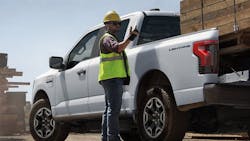Ford CFO: ‘Still a lot of demand’ for commercial equipment, products
Ford Motor Co.’s commercial-vehicle division remains a bright spot heading into 2024 when the automaker will begin to truly absorb the higher costs from its new United Auto Workers contracts, CFO John Lawler said last week.
The order books for Ford Pro—which markets a range of technology and maintenance services as well as work trucks and delivery vans—are “beyond our production capacity today,” Lawler told Barclays analyst Dan Levy at a conference hosted by the bank. He added that demand remains “very robust,” and Ford will benefit next year from higher prices being applied to orders added to its pipeline late this year.
See also: Fleet executives provide first glimpses into ’24
Ford Pro is giving its parent company a big financial shot in the arm this year: It posted a third-quarter EBIT margin of 12% and has produced $5.4 billion in operating profits year to date. For all of last year, the division’s margin was 6.6%, and its EBIT was about $3.2 billion.
Infrastructure and energy investments could boost trucking in 2024
The optimism from Lawler on commercial vehicles jibes with recent commentary from some of his peers in the heavier vocational-truck segment: The leaders of both Paccar Inc. and Daimler Truck Holding AG said after they reported Q3 results that continued investment in infrastructure, energy and other nonresidential construction projects should contribute to 2024 being a very strong year for those parts of their business.
Lawler made his remarks about Pro’s pipeline on Nov. 30 shortly after Ford said that the recently concluded UAW contract negotiations are expected to add about $900 to its costs per vehicle by 2028—a starkly higher figure than the $575 per car over the life of the contract offered by General Motors Corp. earlier last week.
Lawler said on Bloomberg Radio that the new, four-and-a-half-year UAW contracts will add about $500 to each car Ford produces in 2024 before steadily climbing as workers’ wages do. He said he’s unsure why GM’s total impact number is markedly lower.
Ford lost $1.7 billion in profits from the six-week UAW strike, during which the union targeted factories making high-margin trucks and sport-utility vehicles. Workers’ new contracts will cost Ford $8.8 billion over their lives, slightly less than GM’s $9.3 billion forecast.
See also: Is the EV boom turning into a bust?
Like their peers at GM, Lawler and Ford CEO Jim Farley have been reining in spending on electric vehicles of late: A month ago, they said they would push out $12 billion worth of investments in auto and battery plants. And they, too, are pushing to simplify design and manufacturing processes to help absorb the higher labor costs they knew would be coming their way.
“Now it’s our job to go off and drive productivity and efficiencies,” Lawler said. “And we need to do that by reducing the number of hours it takes to build a vehicle, simplifying designs and reducing complexity as well as driving increased efficiencies through our factories.”
One factor from the UAW negotiations that Lawler said will help in those efforts: Ford now has more flexibility to, in consultation with the union, rebalance production lines in its U.S. plants.
About the Author
Geert De Lombaerde
Senior Editor
A native of Belgium, Geert De Lombaerde has more than two decades of experience in business journalism. Since 2021, he has written about markets and economic trends for Endeavor Business Media publications FleetOwner, Healthcare Innovation, IndustryWeek, Oil & Gas Journal, and T&D World.
With a degree in journalism from the University of Missouri, he began his reporting career at the Business Courier in Cincinnati. He later was managing editor and editor of the Nashville Business Journal. Most recently, he oversaw the online and print products of the Nashville Post and reported primarily on Middle Tennessee’s finance sector and many of its publicly traded companies.

